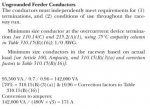I call your attention to Informative Annex D, Example D3(a), of the 2017 NEC, "Industrial Feeders In a Common Raceway".
First, it discusses the fact that the OCPD must "accommodate" 125% of the continuous load plus the non-continuous load. This is for thermal protection of the breaker itself.

Next, it talks about the feeders themselves, and specifically says that "the conductors must
independently meet requirements for (1) terminations, and (2) conditions of use throughout the raceway run." (emphasis mine). Most importantly, note that in this calculation of conductor ampacity, the 125% factor is
not used; only fill and ambient temperature derating are.

Finally, it discusses overcurrent protection, and again in that calculation the 125% factor does not appear. Ampacity for the purpose of breaker sizing is derived from 310.15(B)(16) with fill and temperature derating.

All of this confirms what F. P. Hartwell has been saying for years, as in the articles I linked to.
Back to the topic of the thread, I think this example clearly demonstrates that the 125% factor is entirely concerned with protecting terminations and devices (breakers) from exceeding their thermal limits. A conductor in a raceway is in no danger from running at 100% of its derated ampacity for any length of time, and this is borne out by the fact that the 125% factor is not used in the example in calculating ampacity of the conductor or in calculating the required overcurrent protection. My position is that my 200A breaker is capable of handling more than 125% of the continuous current plus non-continuous, and that setting its trip point to 175A adequately protects a conductor of 160A ampacity. Whether or not I could convince an AHJ of that is another question entirely





